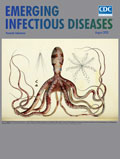
Volume 26, Number 8—August 2020
Dispatch
Leishmania donovani Infection with Atypical Cutaneous Manifestations, Himachal Pradesh, India, 2014–2018
Lovlesh Thakur, Kiran K. Singh, Hemant R. Kushwaha, Sudarshan K. Sharma, Vinay Shankar, Ajeet Negi, Ghanshyam Verma, Sandhya Kumari, Aklank Jain, and Manju Jain
Abstract
We conducted a molecular study of parasite sequences from a cohort of cutaneous leishmaniasis patients in Himachal Pradesh, India. Results revealed atypical cutaneous disease caused by Leishmania donovani parasites. L. donovani variants causing cutaneous manifestations in this region are different from those causing visceral leishmaniasis in northeastern India.
Leishmaniasis is a complex disease with cutaneous, mucocutaneous, or visceral manifestations depending on the parasite species and host immunity. Despite continued elimination efforts, leishmaniasis continues to afflict known and newer endemic regions, where 0.5–0.9 million new cases of visceral leishmaniasis (VL) and 0.6–1.0 million new cases of cutaneous leishmaniasis (CL) occur every year (1). An increase in VL and CL cases from newer foci and atypical disease manifestation pose a challenge to leishmaniasis control programs (2–7). Unlike the known species-specific disease phenotype, parasite variants can cause atypical disease, so that Leishmania species generally associated with VL can cause CL and vice versa.
In India, VL caused by L. donovani parasites in the northeastern region and CL caused by L. tropica in the western Thar Desert represent the prevalent forms of the disease (2). Himachal Pradesh is a more recently leishmaniasis-endemic state in northwest where VL and CL coexist; CL incidence is higher than VL incidence and most cases are attributable to L. donovani instead of L. tropica infection (8,9). Sharma et al. conducted limited molecular analysis of a few CL cases and reported preliminary findings (8). For an in-depth study on the involvement of L. donovani parasites in CL cases, we conducted a comprehensive molecular analysis of CL cases in Himachal Pradesh.






















.png)











No hay comentarios:
Publicar un comentario